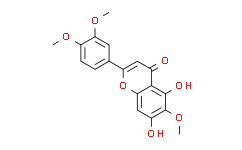| Cas No.: | 22368-21-4 |
| Chemical Name: | Eupatilin |
| Synonyms: | Eupatilin;2-(3,4-Dimethoxyphenyl)-5,7-dihydroxy-6-methoxy-4H-1-benzopyran-4-one;5,7-Dihydroxy-3',4',6-trimethoxyflavone;2-(3,4-Dimethoxyphenyl)-5,7-dihydroxy-6-methoxychromen-4-one;4H-1-Benzopyran-4-one, 2-(3,4-diMethoxyphenyl)-5,7-dihydroxy-6-Methoxy-;5,7-dihydroxy-6,3',4'-trimethoxyflavone;Euptailin;5,7-Dihydroxy-3′,4′,6-trimethoxyflavone;NSC 122413;[ "" ];DRRWBCNQOKKKOL-UHFFFAOYSA-N;4D58O05490;2-(3,4-dimethoxyphenyl)-5,7-dihydroxy-6-methoxy-chromen-4-one;2-(3,4-Dimethoxyphenyl)-5,7-dihydroxy-6-methoxy-4H-chromen-4-one;Eupatilin, >=98% (HPLC);EBD1182;BCP09703;NSC122413;BDBM50060926;LMPK1211122 |
| SMILES: | O1C(=C([H])C(C2C(=C(C(=C([H])C1=2)O[H])OC([H])([H])[H])O[H])=O)C1C([H])=C([H])C(=C(C=1[H])OC([H])([H])[H])OC([H])([H])[H] |
| Formula: | C18H16O7 |
| M.Wt: | 344.3154 |
| Sotrage: | 4°C for 1 year, -20°C for more than 2 years |
| Description: | Eupatilin, a lipophilic flavonoid isolated from Artemisia species, is a PPARα agonist, and possesses anti-apoptotic, anti-oxidative and anti-inflammatory activities. |
| In Vivo: | Eupatilin (1.5% or 3.0%) restores PPARα mRNA expression, and improves atopic dermatitis (AD)-like symptoms in oxazolone-induced Balb/c mice. Eupatilin causes significant decrease in serum IgE, IL-4 levels, oxazolone-induced TNFα, IFNγ, IL-1β, TSLP, IL-33 and IL-25 mRNA expression in oxazolone-induced mice. Eupatilin also increases filaggrin and loricrin mRNA expression in oxazolone-induced mice[1]. |
| In Vitro: | Eupatilin is a PPARα agonist. Eupatilin (10, 30, 100 μM) suppresses IL-4 expression and degranulation in RBL-2H3 cells[1]. Eupatilin (50-100 μM) slightly reduces cell viability of HaCaT cells. Eupatilin (10, 30, 50, 100 μM) increases PPARα transactivation and expression in HaCaT cells. Eupatilin (10, 30, 50 μM) also suppresses TNFα-induced MMP-2/-9 expression in HaCaT cells. Furthermore, Eupatilin inhibits TNFα-induced p65 translocation, IκBα Phosphorylation, AP-1 and MAPK signaling via PPARα[2]. Eupatilin (10-50 μM) shows no cytotoxic effects on ARPE19 cells. Eupatilin (10, 25, 50 μM) elevates cell viability from oxidative stress, and inhibits H2O2-induced ROS production in ARPE19 cells. Moreover, Eupatilin (50 μM) inbibits H2O2-induced cells apoptosis and promotes the activation of PI3K/Akt pathway in RPE cells[3]. |






















